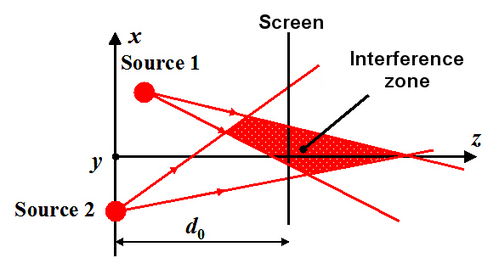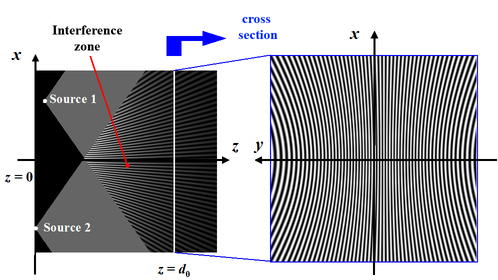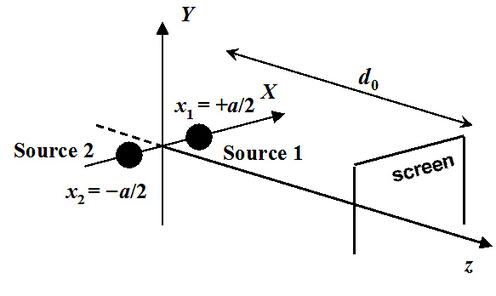
Superposition of two spherical waves
Let us consider two co-polarized (polarized along x direction) spherical waves propagating towards z positives. Figure 5 illustrates this scenario.

In this case, we simply have:
for the first wave, and:
for the second one. Note that
 and
and
 are the coordinates of the point sources. For all coordinates
are the coordinates of the point sources. For all coordinates
 we have:
we have:
The interference phase is
 , i.e:
, i.e:
The interference signal is written as:
Figure 6 shows the interference field in the superposition zone of the two waves on the (x, z) plane to the left, and on the cross-section to the right (plane (x, y, z = d0)).

We can see that the amplitude of interferences decreases with distance from the sources, due to the factor
 of each term of the complex amplitude.
of each term of the complex amplitude.
Moreover, the fringes are curved, which was not the case for the interferences produced by plane waves. In the plane (x, y, z = d0) the fringes are the arcs of a hyperbolae.
In space (x, y, z), a bright fringe is localized by the condition:
i.e:
with
 . This relation is not simple to use.
. This relation is not simple to use.
However, we can write the interfringe distance explicitly in the case of a parabolic approximation. Suppose that
 and
and
 . Assuming this condition is true, a bright fringe is localized by the condition:
. Assuming this condition is true, a bright fringe is localized by the condition:
which gives:
with:
Let us consider an ideal case: suppose that the sources are localized symmetrically on the x axis, one at
 and the other at
and the other at
 with
with
 and
and
 and that the plane observation is defined as
and that the plane observation is defined as
 . Figure 7 illustrates this geometry.
. Figure 7 illustrates this geometry.

In this case it simply follows that:
With this configuration, the fringes are rectilinear and vertical, parallel to the y axis. We can see in figure 6 that this result corresponds to the center of the screen. The bright fringe of the order k is thus localized at xk such that:
And the next bright fringe of the order k+1 is localized at xk+1 such that:
The interfringe distance is thus:
With the parabolic approximation, the interfringe distance is a constant according to the direction x.
Figure 6 shows this result is true at the center of the screen, and that the interfringe distance increases relative to the distance from the center, because the fringes are arcs of hyperbolae.